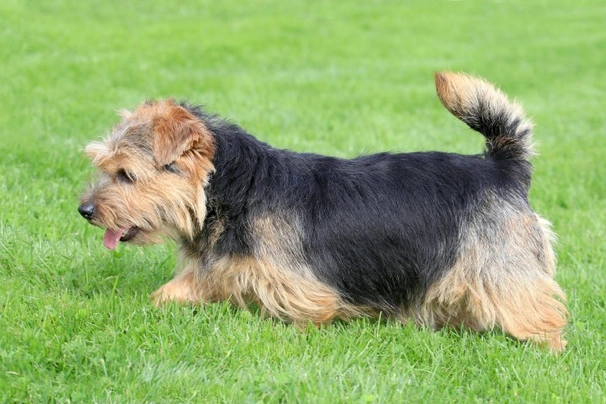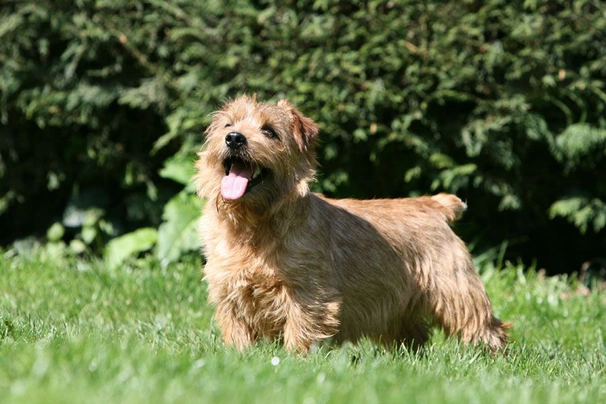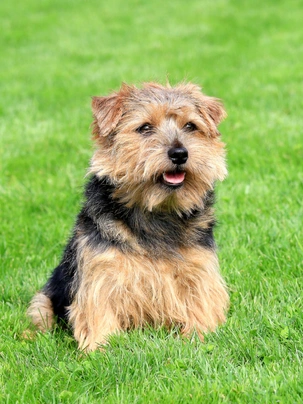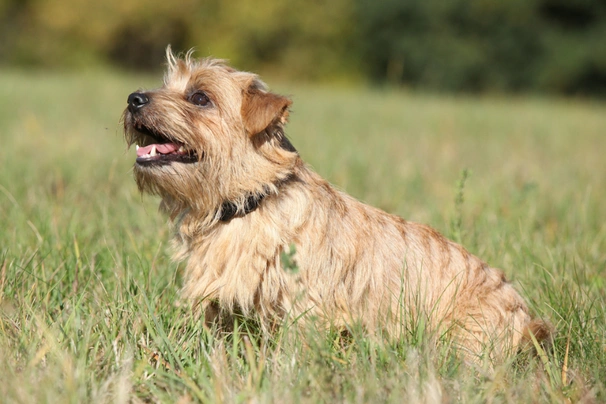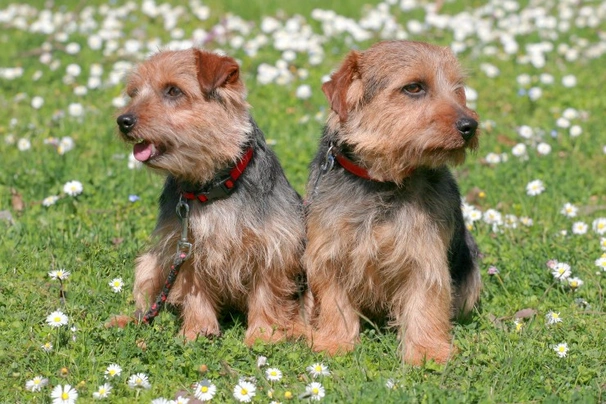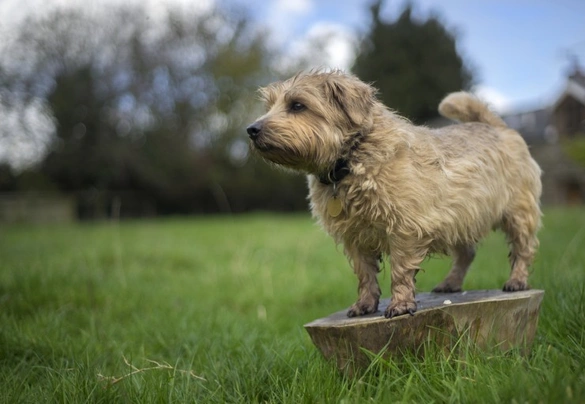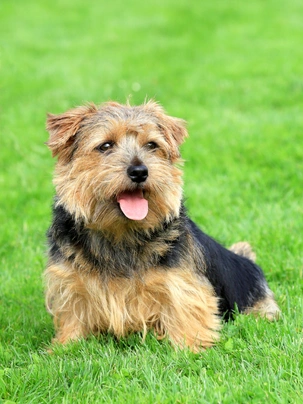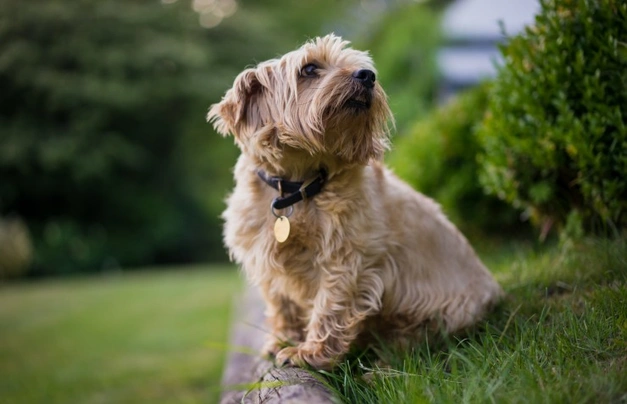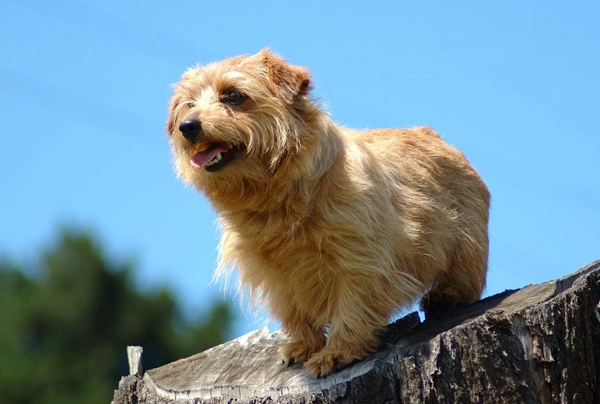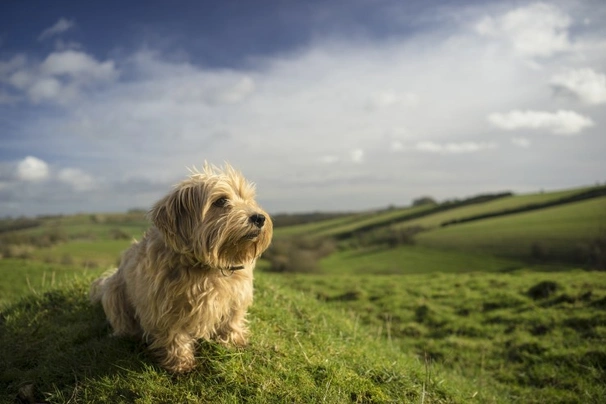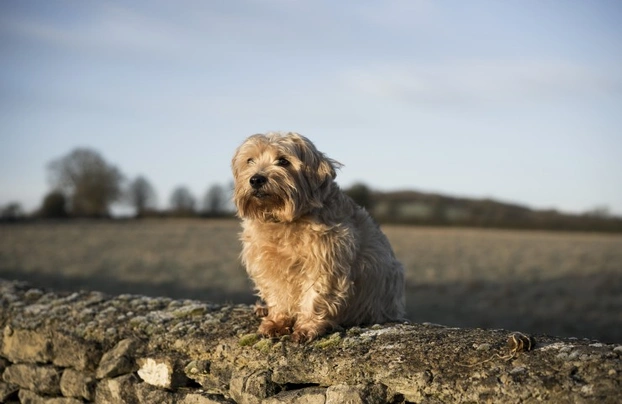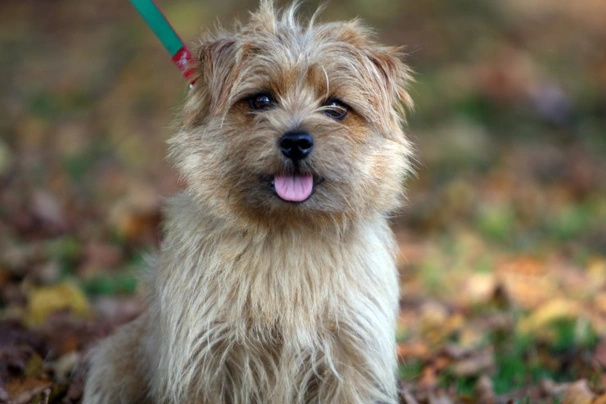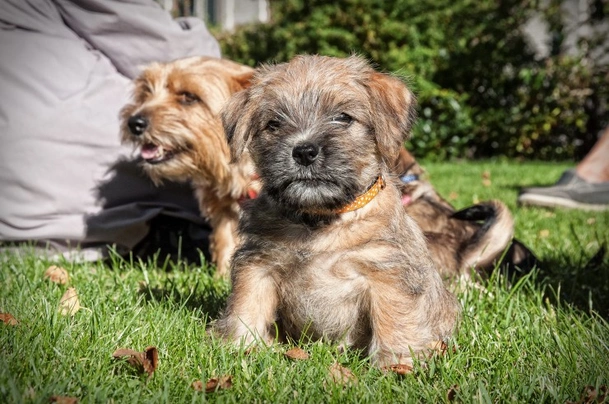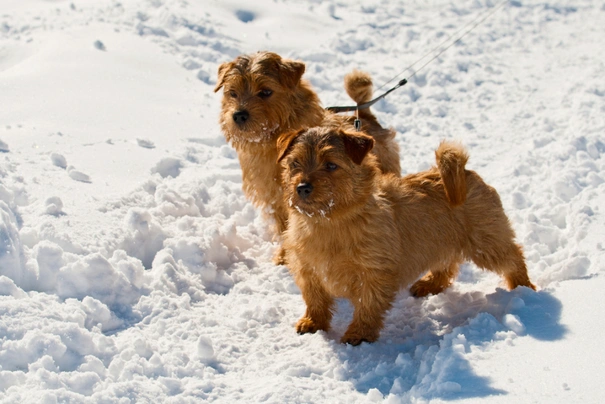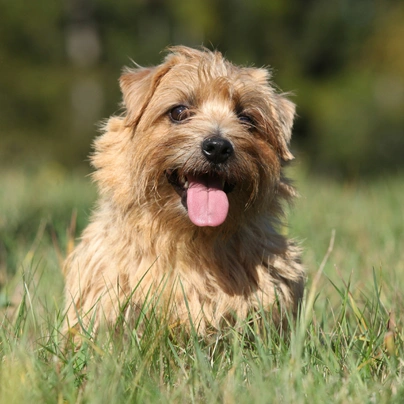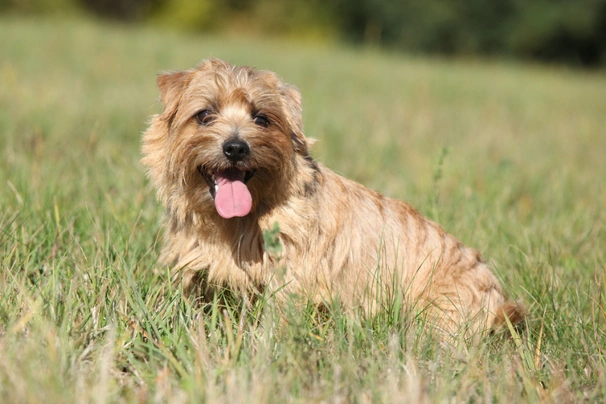Norfolk Terrier
Pros
Cons
Introduction of the Norfolk Terrier
The Norfolk Terrier is the smallest of all the working terrier breeds and like the Norwich Terrier they were named after the county they originated from. These charming little dogs were originally bred to hunt vermin and were also highly prized out hunting too but over the years they have found their way into the hearts and homes of many people and for good reason.
The Norfolk is not only a very sweet looking terrier but they boast having extremely affectionate albeit lively personalities which means sharing a home with one of these terriers is never boring. Although kind natured when around people the Norfolk Terrier retains a very high prey drive and as such should not be trusted around smaller animals and pets just in case they see them as fair game.
History of the Norfolk Terrier
Throughout history Norfolk Terriers have been highly prized for their ratting abilities and were extremely good at keeping the vermin population down although the breed was also a popular terrier on the hunting field back in the day too. There are no early records of the breed but it is thought that these terriers have been around for a long time. However they only found a fanbase outside of Norfolk when the breed was first exhibited at a dog show in 1932. They were shown as drop-eared Norwich Terriers and at the time were recognised by the Kennel Club as such.
Before this small terriers were a popular choice of farmers in Norfolk and Cambridgeshire and as previously mentioned they were used to keep vermin and rodents under control around farms. It is thought that these early "terriers" could well be the ancestors of the Norwich Terrier. However it was in the 19th Century that some students studying at Cambridge University purchased some black and tan terriers from a dealer called Charles Doggy Lawrence. The undergraduates used the terriers to keep the rat population under control in the colleges and they were to become known as "Trumpington Terriers" which was the name of the street the students lived on. The actual origin of these black and tan terriers also remains unknown but there are those who believe they could be the result of crossing a smaller Irish Terrier with a larger Yorkshire Terrier.
Another "terrier" enthusiast called Jodrell Hopkins crossed a small terrier that resembled an Aberdeen to a small red dog that boasted having a silky long coat which was also owned by the dealer "Doggy" Lawrence. He gave one of the puppies called Rags to the Master of the Norwich Staghounds a gentleman called Jack Cooke. Rags had a harsh shaggy red coat with pricked ears and he was an especially good "working" dog. He also proved to be a very good "sire" and produced many nice litters with all his puppies having red coats.
Very soon these little terriers were making their mark on the "hunting" fraternity with more people showing an interest in owning some of them. One of their biggest fans was a man called Frank Jones who was the First Whip for the Norwich Staghounds. He began breeding and selling his puppies all over the country with some even been exported over to the United States. In the US the breed became known as "Jones Terriers".
To establish a breed standard Jones began carefully and selectively breeding his terriers to other terriers using the Bedlington with an end goal being to introduce more "drive" into the breed. A little later he introduced the Staffordshire Bull Terrier into the mix with many breeders choosing to use the "Rags" line thanks to their type and colour.
The first Norwich Terrier to win Breed Championship status was Ch Biffin of Beaufin a terrier that was owned by Mrs. E Mainwaring who weighted down his "pricked" ears so they would drop down because she preferred her terriers to have drop down ears. His influence on the breed remains evident today with many terriers having both drop or prick ears and a lot of Norfolks today can trace their ancestry back to Ch Biffin of Beaufin.
At one time the Breed Club did try to insist that only terriers with prick-ears should be recognised by the Kennel Club although breeders continued to breed from terriers with both types. However eventually breeders did keep to one "type" and by the forties very few Norwich Terriers with mixed ears were around. One of the breed's biggest fans was a Miss Macfie who bred drop-ear terriers and it thanks to her endeavours that by the end of the Second World War more Norwich Terriers with drop-ears were bred over the ensuing years.
At the end of the war dog shows started up again and it was a time when Norfolks with prick-ears were winning Challenge Certificates although a few drop-ear dogs owned by Miss Macfie won too. It was Miss Macfie who worked to have the two types of terrier recognised as separate breeds by the Kennel Club. Finally in 1964 she succeeded with prick-ear terriers being established as "Norwich Terriers" and drop-ears dogs being known as "Norfolk Terriers".
Today Norfolks are still as popular as companions and family pets as they ever were thanks to their charming albeit often feisty terrier natures. They have also found their way into the hearts and homes of many people in other countries of the world. The Norfolk Terrier is also one of the more popular breeds in the showring and again this is thanks to their charming looks and natures.
Interesting facts about the breed
- Is the Norfolk Terrier a vulnerable breed? No they are among some of the more popular dogs in the UK
- At one time both the Norfolk and the Norwich Terrier were classed as one breed
- Norfolks are extremely good ratters
- The breed has always been highly prized by the hunting fraternity in the UK throughout time
- Traditionally a Norfolk Terrier's tail was always docked but since the law banning the procedure came into effect in 2007 tail docking is now illegal with the exception being for some working breeds and if a dog suffers from some sort of health issue that requires their tails to be docked. The procedure must be agreed and authorised before being performed by a qualified vet
Appearance of the Norfolk Terrier
Height at the withers: Males 23 - 25 cm Females 23 - 25 cm
Average weight: Males 5.0 - 5.4 kg Females 5.0 - 5.4 kg
Norfolk Terriers are short-legged little dogs that boast having compact strong bodies. They are built to be excellent ratters a job they excel at. They are the smallest of all the terrier breeds and have broad slightly rounded heads with a nice width between their ears. They have wedge-shaped strong muzzles and well-defined stops. Their eyes can be dark brown or black and oval-shaped with Norfolks always having an intelligent keen and alert look about their eyes.
They have medium sized V-shaped ears with slightly rounded tips which drop forwards lying close to a dog's cheeks. The Norfolk Terrier has a strong jaw with a perfect scissor bite where their upper teeth neatly overlap their lower ones. Their necks are moderately long and strong with dogs having well laid-back shoulders and short well-muscled straight front legs.
Norfolks have compact bodies with short backs and nice level toplines with well sprung ribs. They have powerful hindquarters with well-muscled back legs. Their feet are rounded with strong nails and firm thick pads. Tails are moderately long which adds to the overall well-balanced look of a dog being thicker at the base before tapering to the tip. Norfolks carry their tails as straight as possible and gaily when excited or on the move.
When it comes to their coat the Norfolk Terrier boasts having a straight hard wiry and close lying coat with the hair around their necks and shoulders being rougher than on other parts of their bodies. Their hair on their ears and heads is short and smooth except around their muzzles and over their eyes where the hair is slightly longer forming eyebrows and whiskers. The accepted breed colours for Kennel Club registration are as follows:
- Black & Tan
- Grizzle
- Red
- Red Grizzle
- Red Wheaten
- Wheaten
Norfolks can have some white in their coats which is allowed under their Kennel Club breed standard although not desirable.
Gait/movement
When a Norfolk Terriers moves they do so with purpose having a lot of drive from behind. They move in a forward action at the shoulder with their back legs tracking their front ones. They show a lot of flex both in the hock and stifle while their topline remains level.
Faults
The Kennel Club frowns on any exaggerations or departures from the breed standard and would judge the faults on how much they affect a dog's overall health and wellbeing as well as their ability to perform.
Males should have both testicles fully descended into their scrotums and it is worth noting that a dog can be a little lighter or heavier as well as slightly taller or shorter than set out in the Kennel Club breed standard which is given as a guideline only.
Temperament of the Norfolk Terrier
Norfolks are feisty determined little terriers that don't give up easily when they are in a working environment. They are energetic and always ready to be involved in everything the goes on around them being just at home and happy in a home environment as they are working providing they are given enough to do. They are known to be outgoing confident little dogs that thrive on human company as such they are best suited to families where at least one person stays at home when everyone else is out. They are a good choice for first time owners providing they have the time to dedicate to keeping their canine companion well exercised and busy.
Norfolks tend to like the sound of their own voices which needs to be gently curbed when dogs are still young and before excessive barking develops into a real problem. They also like to dig which sees these little terriers digging up flower beds the lawn and the furniture when the mood takes them and which is another trait that needs to be gently nipped in the bud as soon as possible.
It's important for these little terriers to be well socialised from a young age so they grow up to be confident outgoing mature dogs. Their socialisation must include introducing them to lots of new situations noises people other animals and dogs once they have been fully vaccinated. It's also crucial for their training to start early too and it must be consistent throughout a dog's life. A Norfolk is never happier than when they know their place in the pack and who they can look to for direction and guidance. If they don't know who is the alpha dog in a household they may quickly take on the role of dominant dog which can make them harder to live with and handle.
Are they a good choice for first time owners?
Norfolk Terriers are suited to first time dog owners providing they have the time to dedicated to this type of energetic and intelligent terrier. They also do better living with people who lead active outdoor lives and who like to have an alert canine companion at their side.
What about prey drive?
Norfolk Terriers have a very high prey drive and will happily chase anything that moves or runs away. As such care should be taken as to where and when they can run off the lead more especially if there are wild animals or livestock around. They are very good at turning deaf ear to the recall command when something interesting catches their attention.
What about playfulness?
Norfolk Terriers have a very playful side to their natures and love to entertain and be entertained. They are known to be a little mischievous when the mood takes them and being so clever they quickly learn what pleases an owner and how to get what they want.
What about adaptability?
Although Norfolk Terriers are very adaptable they are better suited to people who have secure back gardens that a dog can safely roam around in whenever they can bearing in mind that Norfolks are highly skilled escape artists and will dig their way of a garden if they can.
What about separation anxiety?
Norfolk Terriers form strong ties with their families and dogs but are quite happy to be left on their own providing it is never for too long. If left to their own devices for long periods of time a Norfolk would quickly find novel ways of amusing themselves which could see them being destructive around the home.
What about excessive barking?
Norfolk Terriers like the sound of their own voices a little too much which is something that needs to be gently nipped in the bud when a dog is still young being careful not to frighten them. They are always quick off the mark to let an owner know when there are strangers about or when something they don't like is going on in their surroundings. With this said any dog will bark unnecessarily and incessantly when left on their own for too long as a way of showing how unhappy they are at the situation.
Do Norfolk Terriers like water?
Most Norfolk Terriers like swimming and will take to the water whenever they can more especially when the weather is hot. However if anyone who owns a dog that does not like water should never force them to go in because it would just end up scaring them. With this said care should always be taken when walking a Norfolk off the lead anywhere near more dangerous watercourses just in case a dog decides to leap in and then needs rescuing because they can't get out of the water on their own.
Are Norfolk Terriers good watchdogs?
Norfolk Terriers are busy when it comes to alerting their owners to when any strangers are about or when something strange is going on in their environment. With this said rarely would a Norfolk do this aggressively preferring to keep their distance and bark.
Intelligence / Trainability of the Norfolk Terrier
The Norfolk Terrier is a smart dog and a fast learner. The downside to this is they are just as quick to pick up bad habits as they are the good. Their training must begin early and it must be consistent and always fair throughout a dog’s life so they understand what their owner expects of them. Norfolks are never happier than when they are given something to do which is why they are so amenable to learning new things.
They excel at many canine sports which includes activities like flat racing and flyball because they thrive on the attention they are given during training and the one-to-one contact when competing with their handlers. The key to successfully training a Norfolk is to make their training as interesting as possible and to avoid too much repetition. It's also a good idea to keep training sessions that much shorter which helps dogs stay more focused on what it’s being asked of them bearing in mind that the more intelligent a dog is the faster they get bored and that Norfolks are very smart little terriers.
They do not answer well to harsh correction or any sort of heavy handed training methods but they do respond extremely well to positive reinforcement which always brings the best out of these intelligent and quick-witted dogs especially when there are high value rewards involved.
Norfolk Terrier puppies are incredibly cute and it is very easy to spoil them when they first arrive in their new homes. However they may be delightful looking but they are incredibly smart too which means they can pick up bad habits quickly and being “terriers” this can soon lead to all sorts of behavioural issues developing. It's important to lay down ground rules and to teach a puppy what is acceptable behaviour and what is not although a Norfolk puppy will always test the boundaries from time to time just to see how much they can get away with. The first commands a puppy should be taught are as follows:
- Come
- Sit
- Stay
- Quiet
- Leave it
- Down
- Bed
Children and other
Norfolk Terriers are known to be very good around children of all ages although playtime might get a bit boisterous. As such any interaction between toddlers and a dog should always be well supervised by an adult to make sure playtime does not get too rough and tumble which could end up with someone being knocked over and hurt.
When dogs have been well socialised from a young enough age they generally get on well with other dogs they meet and if they have grown up with a family cat in a household they usually get on well together. However a Norfolk Terrier would think nothing of chasing off any other cats they encounter because they would see them as fair game. Care should be taken when they are around any smaller animals and pets because of their high prey drive as such any contact is best avoided.
Health of the Norfolk Terrier
The average life expectancy of a Norfolk Terrier is between 12 and 15 years when properly cared for and fed an appropriate good quality diet to suit their ages.
The Norfolk is known to suffer from a few hereditary health issues which are worth knowing about if you are planning share your home with one of these lively little terriers. The conditions that seem to affect the breed the most include the following:
- Heart murmurs - test available
- Bladder Stones
- Cataracts - mainly seen in the older terrier
- Cleft Palate
- Congenital Heart Problems
- Corneal Ulcers
- Crytorchidism/Monorchidism
- Cushing's Disease
- Epilepsy
- Other heart issues
- Hip Problems
- Liver Shunts
- Lumps & Bumps (benign)
- Lumps & Bumps (malignant)
- Luxating Patella
- Demodex mange
- Pancreatitis (Acute)
- Pancreatitis (Chronic)
- Retained Milk Teeth - which need to be surgically removed
- Skin issues
- Sudden Death of Unknown Origin
- Luxating patellas
It is worth noting that many puppies are delivered by C-Section because of the size of their heads.
What about vaccinations?
Norfolk Terrier puppies would have been given their initial vaccinations before being sold but it is up to their new owners to make sure they have their follow-up shots in a timely manner with the vaccination schedule for puppies being as follows:
- 10 -12 weeks old bearing in mind that a puppy would not have full protection straight away but would be fully protected 2 weeks after they have had their second vaccination
There has been a lot of discussion about the need for dogs to have boosters. As such it's best to talk to a vet before making a final decision on whether a dog should continue to have annual vaccinations which are known as boosters.
What about spaying and neutering?
A lot of vets these days recommend waiting until dogs are slightly older before spaying and neutering them which means they are more mature before undergoing the procedures. As such they advise neutering males and spaying females when they are between the ages of 6 to 9 months old and sometimes even when a dog is 12 months old.
Other vets recommend spaying and neutering dogs when they are 6 months old but never any earlier unless for medical reasons. With this said many breeds are different and it is always advisable to discuss things with a vet and then follow their advice on when a dog should be spayed or neutered.
What about obesity problems?
Some Norfolk Terriers gain weight after they have been spayed or neutered and it's important to keep an eye on a dog's waistline just in case they do. If a dog starts to put on weight it's important to adjust their daily calorie intake and to up the amount of exercise they are given. Older dogs too are more prone to gaining weight and again it's essential they be fed and exercised accordingly because obesity can shorten a dog's life by several years. The reason being that it puts a lot of extra strain on a dog's internal organs including the heart which could prove fatal bearing in mind that Norfolks are known to suffer from heart issues.
What about allergies?
Norfolk Terriers are prone to suffering from allergies and it's important for a dog to see a vet sooner rather than later if one flares up. Allergies can be notoriously hard to clear up and finding the triggers can be challenging. With this said a vet would be able to make a dog with an allergy more comfortable while they try to find out the triggers which could include the following:
- Certain dog foods containing high levels of grain and other cereal fillers
- Airborne pollens
- Dust mites
- Environment
- Flea and tick bites
- Chemicals found in everyday household cleaning products
Participating in health schemes
All responsible Norfolk Terrier breeders would ensure that their stud dogs are tested for known hereditary and congenital health issues known to affect the breed by using the following schemes:
Testing for heart murmurs - through the Animal Health Trust
What about breed specific breeding restrictions?
Apart from the standard breeding restrictions that are in place for all Kennel Club registered breeds there are no other breed specific breeding restrictions for the Norfolk Terrier.
What about Assured Breeder Requirements?
There are no Kennel Club Assured Breeder requirements for the Norfolk Terrier at the present time.
Caring for the Norfolk Terrier
As with any other breed Norfolks need to be groomed on a regular basis to make sure their coats and skin are kept in top condition. They also need to be given regular daily exercise to ensure they remain fit and healthy. On top of this dogs need to be fed good quality food that meets all their nutritional needs throughout their lives.
Caring for a Norfolk Terrier puppy
Norfolk Terrier puppies are boisterous and full of life which means it's essential for homes and gardens to be puppy-proofed well in advance of their arrival. A responsible breeder would have well socialised their puppies which always leads to more outgoing confident and friendly dogs right from the word go. With this said any puppy is going to feel vulnerable when they leave their mother and littermates which must be taken into account. The longer a puppy can remain with their mother the better although it should never be for too long either.
It's best to pick a puppy up when people are going to be around for the first week or so which is the time needed for a puppy to settle in. Puppy-proofing the home and garden means putting away any tools and other implements that a boisterous puppy might injure themselves on. Electric wires and cables must be put out of their reach because puppies love chewing on things. Toxic plants should be removed from flowerbeds and the home too.
Puppies need to sleep a lot to grow and develop as they should which means setting up a quiet area that's not too out of the way means they can retreat to it when they want to nap and it's important not to disturb them when they are sleeping. It's also a good idea to keep "playtime" nice and calm inside the house and to have a more active "playtime" outside in the garden which means puppies quickly learn to be less boisterous when they are inside.
The documentation a breeder provides for a puppy must have all the details of their worming date and the product used as well as the information relating to their microchip. It is essential for puppies to be wormed again keeping to a schedule which is as follows:
- Puppies should be wormed at 6 months old
- They need to be wormed again when they are 8 months old
- Puppies should be wormed when they are 10 months old
- They need to be wormed when they are 12 months old
Things you'll need for your puppy
There are certain items that new owners need to already have in the home prior to bringing a new puppy home. It's often a good idea to restrict how much space a puppy plays in more especially when you can't keep an eye on what they get up to bearing in mind that puppies are often quite boisterous which means investing in puppy gates or a large enough playpen that allows a puppy the room to express themselves while keeping them safe too. The items needed are therefore as follows:
- Good quality puppy or baby gates to fit on doors
- A good well-made playpen that's large enough for a puppy to play in so they can really express themselves as puppies like to do
- Lots of well-made toys which must include good quality chews suitable for puppies to gnaw on bearing in mind that a puppy will start teething anything from when they are 3 to 8 months old
- Good quality feed and water bowls which ideally should be ceramic rather than plastic or metal
- A grooming glove
- A slicker brush or soft bristle brush
- Dog specific toothpaste and a toothbrush
- Scissors with rounded ends
- Nail clippers
- Puppy shampoo and conditioner which must be specifically formulated for use on dogs
- A well-made dog collar or harness
- A couple of strong dog leads
- A well-made dog bed that's not too small or too big
- A well-made dog crate for use in the car and in the home that's large enough for a puppy to move around in
- Baby blankets to put in your puppy's crate and in their beds for when they want to nap or go to sleep at night
Keeping the noise down
All puppies are sensitive to noise including Norfolk Terrier puppies. It's important to keep the noise levels down when a new puppy arrives in the home. TVs and music should not be played too loud which could end up stressing a small puppy out.
Keeping vet appointments
As previously mentioned Norfolk Terrier puppies would have been given their first vaccinations by the breeders but they must have their follow up shots which is up to their new owners to organise. The vaccination schedule for puppies is as follows:
- 10 -12 weeks old bearing in mind that a puppy would not have full protection straight away but would only be fully protected 2 weeks after they have had their second vaccination
When it comes to boosters it's best to discuss these with a vet because there is a lot of debate about whether a dog really needs them after a certain time. However if a dog ever needed to go into kennels their vaccinations would need to be
What about older Norfolk Terriers when they reach their senior years?
Older Norfolk Terriers need lots of special care because as they reach their golden years they are more at risk of developing certain health concerns. Physically a dog's muzzle may start to go grey but there will be other noticeable changes too which includes the following:
- Coats become coarser
- A loss of muscle tone
- Norfolks can either become overweight or underweight
- They have reduced strength and stamina
- Older dogs have difficulty regulating their body temperature
- They often develop arthritis
- Immune systems do not work as efficiently as they once did which means dogs are more susceptible to infections
Older dogs change mentally too which means their response time tends to be slower as such they develop the following:
- They respond less to external stimuli due to impaired vision or hearing
- They tend to be a little pickier about their food
- They have a lower pain threshold
- Become intolerant of any change
- Often an older dog can feel disorientated
Living with a Norfolk Terrier in their golden years means taking on a few more responsibilities but these are easily managed and should include taking a look at their diet the amount of exercise they are given how often their dog beds need changing and keeping an eye on the condition of their teeth.
Older Norfolk Terriers need to be fed a good quality diet that meets their needs at this stage of their lives all the while keeping a close eye on a dog's weight. A rough feeding guide for older dogs is as follows bearing in mind they should be fed highly digestible food that does not contain any additives:
- Protein content should be anything from 14 – 21%
- Fat content should be less than 10%
- Fibre content should be less than 4%
- Calcium content should be 0.5 – 0.8%
- Phosphorous content should be 0.4 – 0.7%
- Sodium content should be 0.2 – 0.4%
Older Norfolk Terriers don't need to be given the same amount of daily exercise as a younger dog but they still need the right amount of physical activity to maintain muscle tone and to prevent a dog from putting on too much weight. All dogs need access to fresh clean water and this is especially true of older dogs when they reach their golden years because they are more at risk of developing kidney disorders.
Grooming of the Norfolk Terrier
Norfolk Terriers have a harsh wiry top coat that consists of longer hair around their necks shoulders and on their legs. They are medium maintenance on the grooming front with their coats needing to be brushed several times a week to prevent any knots from forming. Their coats also benefit from being professionally hand stripped 2 to 3 years a year which makes keeping their coats in good condition and healthy that much easier in between visits to a grooming parlour.
They shed steadily throughout the year only more so during the Spring and then again in the Autumn when more frequent grooming is usually necessary to stay on top of things and to remove dead and shed hair from a dog's coat. It's important to check a dog's ears on a regular basis and to gently pluck any excess hair when necessary which is best left up to a professional groomer. Their ears need to be checked and cleaned them when necessary too because if too much wax builds up it can lead to a painful infection which can be hard to clear up. In short prevention is often easier than cure with ear infections.
Exercise of the Norfolk Terrier
The Norfolk Terrier is a high energy intelligent dog and as such they need to be given the right amount of daily exercise and mental stimulation for them to be truly happy well-rounded dogs. They need anything from 40 to 60-minutes exercise a day with as much off the lead time as possible but only in a safe environment. If they are not given the right amount of mental stimulation and exercise every day a Norfolk would quickly get bored and could even begin to show some destructive behaviours around the home which is their way of relieving any stress they are feeling and not necessarily because they are being naughty.
A shorter walk in the morning would be fine but a longer more interesting one in the afternoon is a must with as much off the lead time as possible. These dogs also like to be able to roam around a back garden so they can really let off steam. However the fencing must be extremely secure to keep these active high-energy dogs in because if they find a weakness in the fence they will soon escape and could get into all sorts of trouble bearing in mind that Norfolk Terriers are experts when it comes to digging their way out of a garden.
With this said Norfolk puppies should not be over exercised because their joints and bones are still growing. This includes not letting a dog jump up and down from furniture or going up or down the stairs. Too much pressure placed on their joints and spines at an early age could result in a dog developing serious problems later in their lives.
Feeding of the Norfolk Terrier
If you get a Norfolk Terrier puppy from a breeder they would give you a feeding schedule and it's important to stick to the same routine feeding the same puppy food to avoid any tummy upsets. You can change a puppy's diet but this needs to be done very gradually always making sure they don't develop any digestive upsets and if they do it's best to put them back on their original diet and to discuss things with the vet before attempting to change it again.
Older dogs are not known to be fussy eaters but this does not mean they can be given a lower quality diet. It's best to feed a mature dog twice a day once in the morning and then again in the evening making sure it's good quality food that meets all their nutritional requirements. It's also important that dogs be given the right amount of exercise so they burn off any excess calories or they might gain too much weight which can lead to all sorts of health issues. Obesity can shorten a dog's life by several years so it's important to keep an eye on their waistline from the word go.
Feeding guide for a Norfolk Terrier puppy
Puppies need to be fed a highly nutritious good quality diet for them to develop and grow as they should. As a rough guide a Norfolk puppy can be fed the following amounts every day making sure their meals are evenly spread out throughout the day and it's best to feed them 3 or 4 times a day:
- 2 months old - 92g to 102g depending on puppy's build
- 3 months old - 108g to 118g depending on puppy's build
- 4 months old - 114g to 124g depending on puppy's build
- 5 months old - 115g to 125g depending on puppy's build
- 6 months old - 114 g to 124g depending on puppy's build
- 7 months old - 92g to 112g depending on puppy's build
- 8 months old - 90g to 100g depending on puppy's build
- 9 months old - 79g to 89g depending on puppy's build
- 10 months old - 78g to 88g depending on puppy's build
Once a puppy is 11 months old they can be fed adult dog food.
Feeding guide for an adult Norfolk Terrier
Once fully mature an adult Norfolk Terrier must be fed a good quality diet to ensure their continued good health. As a rough guide an adult Norfolk can be fed the following amounts every day:
- Dogs weighing 5 kg can be fed 80g to 93g depending on activity
- Dogs weighing 5.4 kg can be fed 85g to 98g depending on activity
Norfolk Terrier price
If you are looking to buy a Norfolk Terrier you would need to pay anything from £500 to over £1000 for a well-bred pedigree puppy. The cost of insuring a male 3-year-old Norfolk in northern England would be £10.82 a month for basic cover but for a lifetime policy this would set you back £42.29 a month (quote as of December 2017). When insurance companies calculate a pet's premium they factor in several things which includes where you live in the UK a dog's age and whether they have been neutered or spayed among other things.
When it comes to food costs you need to buy the best quality food whether wet or dry making sure it suits the different stages of a dog’s life. This would set you back between £20 - £30 a month. On top of this you need to factor in veterinary costs if you want to share your home with a Norfolk and this includes their initial vaccinations their annual boosters the cost of neutering or spaying a dog when the time is right and their yearly health checks all of which quickly adds up to over £800 a year.
As a rough guide the average cost to keep and care for a Norfolk Terrier would be between £50 to £80 a month depending on the level of insurance cover you opt to buy for your dog but this does not include the initial cost of buying a well-bred healthy Kennel Club registered pedigree Norfolk Terrier puppy.
Buying advice
When visiting and buying any puppy or dog there are many important things to consider and questions to ask of the breeder/seller. You can read our generic puppy/dog advice here which includes making sure you see the puppy with its mother and to verify that the dog has been wormed and microchipped.
Norfolk Terriers are among one of the more popular breeds both in the UK and elsewhere in the world which means that well-bred puppies can often command a lot of money. As such with Norfolk Terriers there is specific advice questions and protocols to follow when buying a puppy which are as follows:
- Beware of online scams and how to avoid them. You may see online and other adverts by scammers showing images of beautiful Norfolk Terrier puppies for sale at very low prices. However the sellers ask buyers for money up front before agreeing to deliver a puppy to a new home. Potential buyers should never buy a puppy unseen and should never pay a deposit or any other money online to a seller. You should always visit the pet at the sellers home to confirm they are genuine and make a note of their address.
- As previously touched upon Norfolk Terriers are among some of the most popular breeds in the UK. As such there are many amateur breeders/people who breed from a dam far too often so they can make a quick profit without caring for the welfare of the puppies their dam or the breed in general. Under Kennel Club rules a dam must only produce 4 litters and she must be between a certain age to do so. Anyone wishing to buy a Norfolk Terrier puppy should think very carefully about who they purchase their puppy from and should always ask to see the relevant paperwork pertaining to a puppy's lineage their vaccinations and their microchipping.
- Prospective owners should be very careful when considering buying a Norfolk Terrier puppy with a docked tail because it is now illegal. With this said a working dog may have their tails docked or for medical reasons but the right permissions must be granted by the correct authorities and the procedure must be carried out by a qualified vet. Owners and breeders would be liable for heavy fines if they dock a terrier's tail without the correct permissions.

